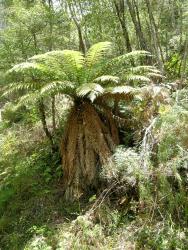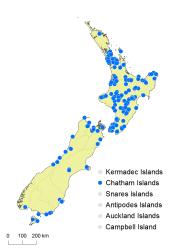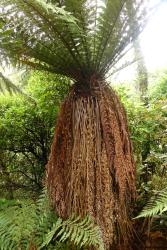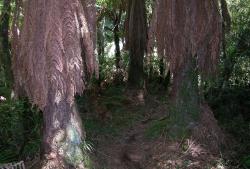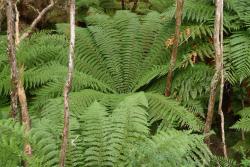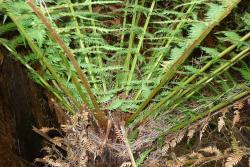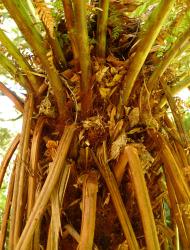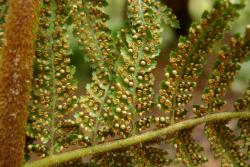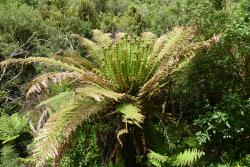- Taxon
- Gallery
- ≡ Balantium fibrosum (Colenso) Fée, Mém. Foug., 5. Gen. Filic. 341 (1852)
- ≡ Dicksonia antarctica var. fibrosa (Colenso) Kirk, Trans. & Proc. New Zealand Inst. 10 (app.): xliii (1878)
- = Dicksonia sparmanniana Colenso, Trans. & Proc. New Zealand Inst. 12: 363 (1880)
- = Dicksonia microcarpa Colenso, Trans. & Proc. New Zealand Inst. 20: 214 (1888)
- ≡ Dicksonia fibrosa var. microcarpa (Colenso) C.Chr., Index Filic. 221-222 (1905)
Rhizomes erect, forming a woody trunk 2–6 m tall, 150–600 mm diam., or rarely to 1000 mm on Chatham Islands, covered in a thick layer of reddish brown adventitious roots, lacking buds and underground stolons, bearing reddish brown multicellular hairs near the apex. Fronds 1100–3000 mm long, held erect when young, persistent, forming a thick skirt completely obscuring the trunk when old; dead fronds pale brown. Stipes 50–500 mm long, red-brown at very base, becoming pale brown or yellow-brown distally, smooth, often bearing fine golden-brown hairs at the junction with the trunk, densely covered in red-brown multicellular hairs up to 45 mm long proximally, and pale brown or red-brown hairs up to 3 mm long distally. Laminae 2-pinnate-pinnatisect, narrowly elliptic or narrowly obovate, 950–2800 mm long, 210–600 mm wide, dark green on adaxial surfaces, paler green on abaxial surfaces, coriaceous, harsh, abundantly hairy on abaxial surfaces of rachis, pinna midribs and costae; hairs fine, multicellular, colourless or pale or chestnut-brown, more or less straight, up to c. 1 mm long, uniformly distributed; rachis yellow-brown or pale brown. Primary pinnae in 25–45 pairs, narrowly ovate or narrowly triangular; the longest at or above the middle, 135–390 mm long, 40–115 mm wide, stalked; the basal pair 20–95 mm long. Secondary pinnae narrowly ovate or narrowly triangular, the longest 20–65 mm long, 5–15 mm wide, stalked or sessile. Longest tertiary pinnae 3–10 mm long, 2–3 mm wide, adnate, fertile ones divided less than halfway to midrib; ultimate segments sharply angled. Sori terminating veins at margins of lamina, ovate, c. 1 mm long, slightly elongated along the lamina margin.
Dicksonia fibrosa is recognised by its thick fibrous trunk, skirt of persistent entire dead fronds, and crown of short-stalked and rather narrow fronds. The pair of basal primary pinnae are less than 95 mm long. New fronds are produced in flushes in spring, and are initially held upright, gradually drooping lower as they mature and die to form the skirt.
North Island: Northland, Auckland, Volcanic Plateau, Gisborne, Taranaki, Southern North Island.
South Island: Western Nelson, Sounds-Nelson, Marlborough, Westland, Canterbury, Otago, Southland, Fiordland.
Chatham Islands, Stewart Island.
Altitudinal range: 10–1100 m.
Dicksonia fibrosa occurs in lowland and montane areas of much of the North Island from Kaipara Harbour southwards, with an isolated record from Puketi Forest (WELT P018474) that may be an escape from cultivation (Brownsey et al. 2013). It extends from near sea level, to over 1100 m in the Kaweka and Ruahine ranges. In the South Island, it is found mainly in coastal and lowland areas from north-west Nelson to Lake Mapourika on the west coast, in scattered localities on the east coast from the Marlborough Sounds to the Catlins, and on the south coast as far west as Lake Poteriteri in Fiordland. It is virtually absent from the interior of the South Island. It is also present on Stewart Island where it is described as "rare and local" (Wilson 1982). It occurs from sea level, up to about 400 m around Nelson and in the headwaters of the Kēkerengū River, Marlborough. There is a single record from c. 900 m in the Jordan Stream Reserve, Marlborough.
All records north of 37°30’ S have been made since 1969, and the northernmost collections made by early botanists such as Cheeseman, Kirk and Petrie came from Raglan and the Mamaku Plateau. Brownsey et al. (2013) investigated the distribution of D. fibrosa in the wider Auckland area and concluded that it probably extends naturally to about 36°30’ S, reaching the Kaipara region and Te Moehau, but is very uncommon north of a line from Raglan to the Bay of Plenty. Although there are numerous records of the species in the Auckland region, most of these are from populations of just one or two plants, and it is likely that they are naturalised plants that have originated from cultivated sources in urban areas. The frequency of naturalised plants, especially in Auckland City, may be masking the rarity of natural populations at the northern end of its range.
Dicksonia fibrosa has been recorded as naturalised on Hawai’i (Lorence & Flynn 2006).
Occurs under tall mānuka and kānuka scrub, on forest margins, or in podocarp and broad-leaved forest in the northern part of its range, and podocarp or beech forest in the southern part. It grows on flood plains, riverbanks, streamsides, swamp margins and on hillsides, but can also tolerate forest margins, open pastures or scrubland.
This species was first collected by Colenso during his journey through the Urewera Ranges in 1841–42, and later published as D. fibrosa in the Tasmanian Journal of Natural Sciences (Colenso 1845). Until recently, this has been accepted as the earliest validly published description (Brownsey et al. 1985). However, Colenso sent a specimen (No. 289) and a copy of an unpublished description to W.J. Hooker in a letter dated 1 September 1842 (see St. George 2009). Hooker then used Colenso's specimen and description to draw up his own description for inclusion in Species Filicum (Hooker 1844–1846). He specifically says about D. fibrosa, "of this species I only possess portions of a large frond, with copious fructifications. But, happily, Mr Colenso's description is before me, from which I have been able to improve the specific character". He attributes the name to Colenso, includes a portion of Colenso’s description in quotation marks, and cites Colenso’s article in the Tasmanian Journal of Natural Science, albeit without volume or page numbers. Hooker did not intend to pre-empt Colenso, expecting Colenso's description to have been published before his, but in the event Species Filicum appeared in print first, and is the first validly published description for the species. Because Hooker attributed the name and part of the description to Colenso, the species must be cited as Dicksonia fibrosa Colenso in Hook. (K. Gandhi, pers. comm. – Art. 46.2 Note 1).
There are two specimens collected by Colenso from the Te Waiiti district – one at WELT (P003256), and the other at K (Colenso 289). Both specimens are very similar, comprising three pinna pairs from the mid-portion of the lamina. The sheet at K also has an unattached pinna, while that at WELT has a portion of the frond apex. Allan (1961) lectotypified the WELT specimen.
Colenso also described the species twice more as D. sparmanniana and D. microcarpa, but these are just minor variants of his original species. There are several syntype specimens of both D. sparmanniana and D. microcarpa in WELT, but, for both taxa, the description by Allan (1961) of the type material on a particular sheet (e.g. "…a portion of the rachis with 7 pinnae…") constitutes lectotypification.
Dicksonia intermedia Colenso ex Hook. & Baker (1874), cited under D. fibrosa by Allan (1961), is a nomen nudum.
The status of D. fibrosa as a species distinct from the Australian D. antarctica requires further investigation. Hooker (1867) could not find any difference between the two and treated the New Zealand plant as D. antarctica. Kirk (1878) reduced it to a variety of D. antarctica, noting its smaller size, hairy rachis, more compact habit and less coriaceous texture. Cheeseman (1925) accepted it as D. fibrosa only rather reluctantly, stating that it was "very close indeed to the Australian D. antarctica", differing in being a smaller plant with densely hairy rachises and smaller sori. Cheeseman’s recognition of D. fibrosa has been followed by later authors (e.g. Allan 1961; Brownsey et al. 1985). Page & Hollands (1992) identified a number of characters for distinguishing Australian and New Zealand species of Dicksonia in cultivation in Britain, including D. antarctica and D. fibrosa. However, many of the measurements given do not apply to the two species in the wild, and the comparison is therefore of limited value. In fact, the most striking difference between the two species, not mentioned by any of the above authors, is that D. fibrosa has a thick skirt of dead fronds surrounding the trunk, which D. antarctica lacks. The primary pinnae of D. antarctica are generally broader than those of D. fibrosa, and the stipes often rather longer. Also, Janssen et al. (2008) found a small genetic difference between the two species, which may be significant given the deceleration of molecular evolution observed in tree ferns (Korall et al. 2010). These differences suggest that two species should continue to be recognised for the time being.



